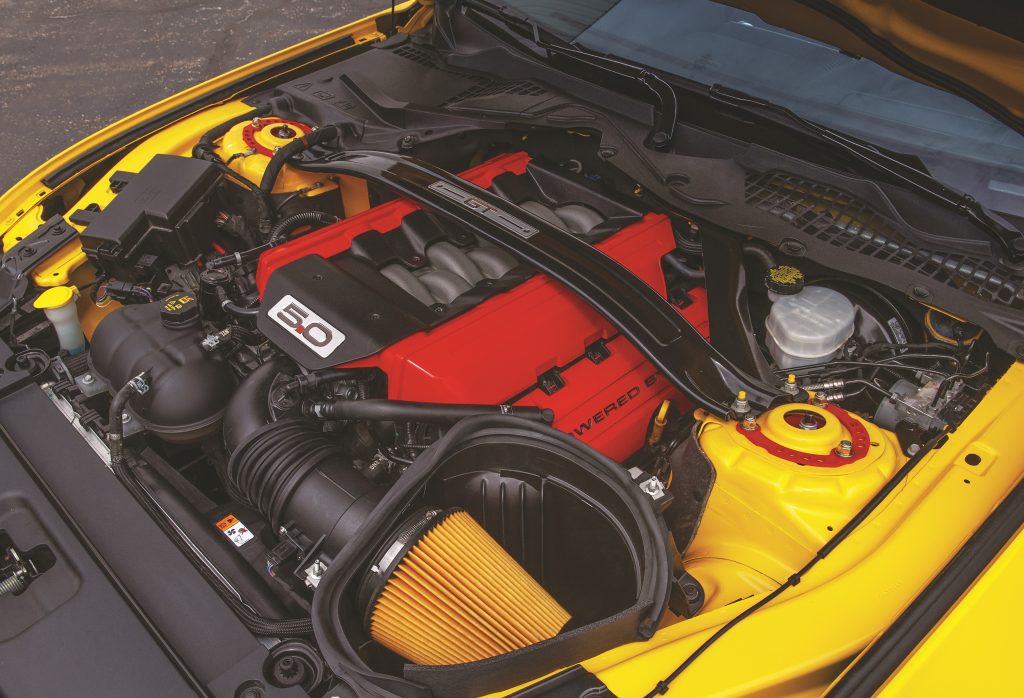The world first met the new Ford 5.0L Coyote V8 in the 2011 Mustang and F-150.
And there was plenty for the Blue Oval Brigade to be excited about.
Not only did it resurrect the iconic five liter displacement and obligatory “5.0” Mustang fender badge, the new Coyote 5.0L V8 built upon the success of Ford’s long-running Modular motor family. It boasted some significant enhancements to the Modulars that preceded it too, with features like Ford’s Twin Independent Variable Camshaft Timing (Ti-VCT) and, later on, direct injection.
Yet Ford didn’t bask in the initial success of the Coyote, and the Blue Oval continued to update and tweak its new 5.0L V8 along its decade-plus production run.
In fact, there were three evolutions (so far) of the Ford 5.0L Coyote. And, perhaps more importantly, the engines were distinct between the car-biased Coyote found in the Mustang and the truck-biased Coyote found in the F-150—most notably the truck motor’s compatibility with ethanol-blended Flex Fuels like E85.
All told, there are six* versions of the Coyote. Here’s how the generations break out—and you can click on each one to see detailed engine spec guides on each distinct Ford Coyote V8 engine.
Ford Mustang GT 5.0L Coyote “Car” Engines
- 2011-14 Ford Mustang GT 5.0L First-Gen Coyote Engine Spec Guide
- 2015-17 Ford Mustang GT 5.0L Second-Gen Coyote Engine Spec Guide
- 2018-23 Ford Mustang GT 5.0L Third-Gen Coyote Engine Spec Guide
Ford F-150 5.0L Coyote “Truck” Engines
- 2011-14 Ford F-150 5.0L First-Gen Coyote Truck Engine Spec Guide
- 2015-17 Ford F-150 5.0L Second-Gen Coyote Truck Engine Spec Guide
- 2018-23 Ford F-150 5.0L Third-Gen Coyote Truck Engine Spec Guide
* But wait! There’s actually a seventh Ford 5.0L Coyote-derived engine: The race-bred, rip-snortin’ “Road Runner” 5.0L V8 found in the 2012 and 2013 Mustang Boss 302. You can read all about the Ford 5.0L Coyote Road Runner engine here.
***
Special thanks to the Summit Racing tech team of John Jones, Gary Vicich, and Matt Strebler for all of their efforts in compiling these detailed Ford Coyote engine spec guides.
***
Spotter’s Guide: Differences Between the Ford 5.0L Coyote V8 Engines
If you’ve got a late-model Ford Mustang or a F-150 pickup truck with one of these engines, figuring out which exact Coyote motor it has is often as simple as identifying its year. But there are also a few things to look for, say, if you come across a Coyote 5.0L resting on a pallet in a scrapyard.
For starters, the color of the intake manifold (black or gray) can tell you if it’s a car or truck engine.
Then you can check the intake manifold for a Charge Motion Control Valve. Often abbreviated as CMCV, it’s a technology that’s built into some Coyote engines that, in a nutshell, is there to control and adjust airflow to optimize fuel efficiency and performance.
And in its 2018 update, Ford added direct injection to the 5.0L Coyote’s resume. See a simplified explanation of the differences between each distinct Coyote engine in the table below.
Differences Between the Ford 5.0L Coyote V8 Engines
| VIN | Intake Manifold Color | CMCV | Direct Injection | |
|---|---|---|---|---|
| Gen 1 F-150 | F | Black | No | No |
| Gen 1 Mustang | F | Gray | No | No |
| Gen 2 F-150 | F | Black | Yes | No |
| Gen 2 Mustang | F | Gray | Yes | No |
| Gen 3 F-150 | 5 | Black | Yes | Yes |
| Gen 3 Mustang | F | Gray | Yes | Yes |
Ford 5.0L Coyote Engine VIN Identification Guide
Here’s a more detailed breakout of the Coyote family VIN and vehicle applications too.
| 2011-14 Ford Mustang GT 5.0L First-Gen Coyote Engine Application & VIN ID | |
|---|---|
| VIN 8th Digit | F |
| Years | 2011-14 |
| Make | Ford |
| Model | Mustang GT |
| 2015-17 Ford Mustang GT 5.0L Second-Gen Coyote Engine Application & VIN ID | |
|---|---|
| VIN 8th Digit | F |
| Years | 2015-18 |
| Make | Ford |
| Model | Mustang GT |
| 2018-23 Ford Mustang GT 5.0L Third-Gen Coyote Engine Application & VIN ID | |
|---|---|
| VIN 8th Digit | F |
| Years | 2018-23 |
| Make | Ford |
| Model | Mustang GT |
| 2012-13 Ford Mustang Boss 302 Road Runner Engine Application & VIN ID | |
|---|---|
| VIN 8th Digit | U |
| Years | 2012 & 2013 |
| Make | Ford |
| Model | Mustang Boss 302 |
| 2011-14 Ford F-150 5.0L First-Gen Coyote Truck Engine Application & VIN ID | |
|---|---|
| VIN 8th Digit | F |
| Years | 2011-14 |
| Make | Ford |
| Model | F-150 |
| 2015-17 Ford F-150 5.0L Second-Gen Coyote Truck Engine Application & VIN ID | |
|---|---|
| VIN 8th Digit | F |
| Years | 2015-18 |
| Make | Ford |
| Model | F-150 |
| 2018-23 Ford F-150 5.0L Third-Gen Coyote Truck Engine Application & VIN ID | |
|---|---|
| VIN 8th Digit | 5 |
| Years | 2018-23 |
| Make | Ford |
| Model | F-150 |


Comments